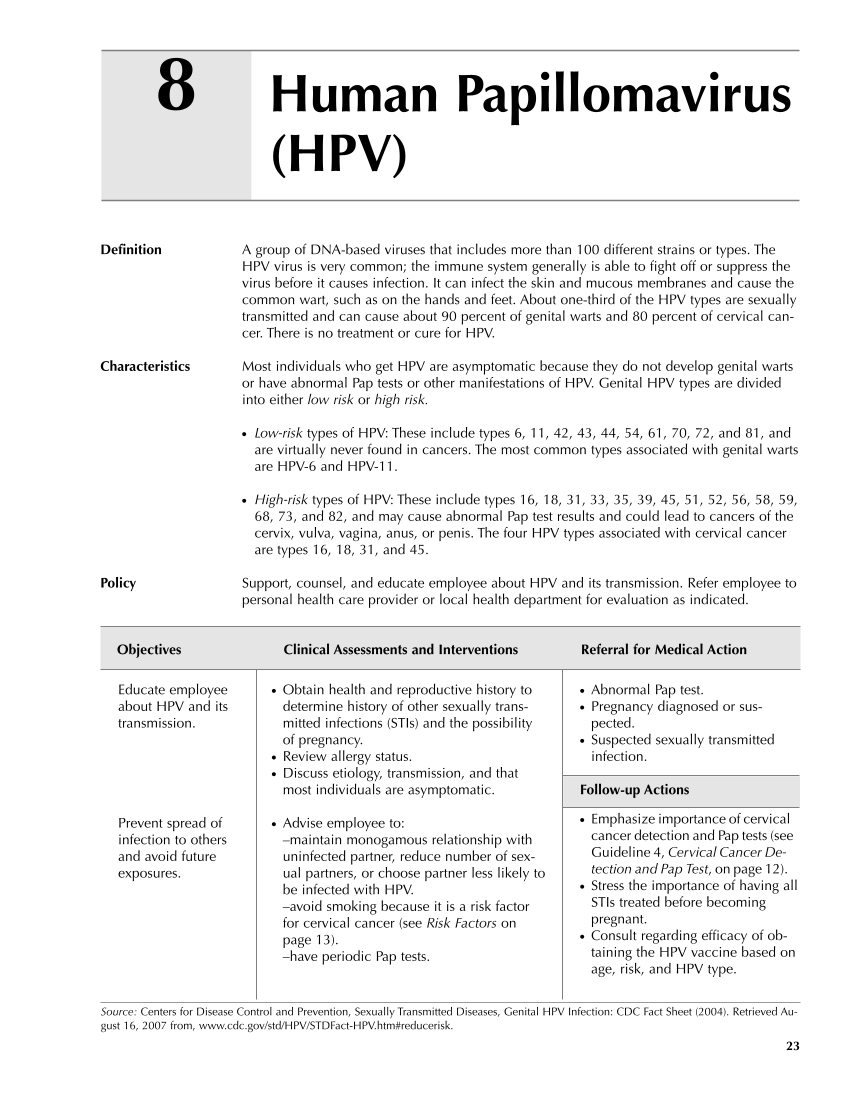23 Human Papillomavirus (HPV) 8 Definition A group of DNA-based viruses that includes more than 100 different strains or types. The HPV virus is very common the immune system generally is able to fight off or suppress the virus before it causes infection. It can infect the skin and mucous membranes and cause the common wart, such as on the hands and feet. About one-third of the HPV types are sexually transmitted and can cause about 90 percent of genital warts and 80 percent of cervical can- cer. There is no treatment or cure for HPV. Characteristics Most individuals who get HPV are asymptomatic because they do not develop genital warts or have abnormal Pap tests or other manifestations of HPV. Genital HPV types are divided into either low risk or high risk. ● Low-risk types of HPV: These include types 6, 11, 42, 43, 44, 54, 61, 70, 72, and 81, and are virtually never found in cancers. The most common types associated with genital warts are HPV-6 and HPV-11. ● High-risk types of HPV: These include types 16, 18, 31, 33, 35, 39, 45, 51, 52, 56, 58, 59, 68, 73, and 82, and may cause abnormal Pap test results and could lead to cancers of the cervix, vulva, vagina, anus, or penis. The four HPV types associated with cervical cancer are types 16, 18, 31, and 45. Policy Support, counsel, and educate employee about HPV and its transmission. Refer employee to personal health care provider or local health department for evaluation as indicated. Objectives Clinical Assessments and Interventions Referral for Medical Action ● Abnormal Pap test. ● Pregnancy diagnosed or sus- pected. ● Suspected sexually transmitted infection. Follow-up Actions ● Emphasize importance of cervical cancer detection and Pap tests (see Guideline 4, Cervical Cancer De- tection and Pap Test, on page 12). ● Stress the importance of having all STIs treated before becoming pregnant. ● Consult regarding efficacy of ob- taining the HPV vaccine based on age, risk, and HPV type. Educate employee about HPV and its transmission. Prevent spread of infection to others and avoid future exposures. ● Obtain health and reproductive history to determine history of other sexually trans- mitted infections (STIs) and the possibility of pregnancy. ● Review allergy status. ● Discuss etiology, transmission, and that most individuals are asymptomatic. ● Advise employee to: –maintain monogamous relationship with uninfected partner, reduce number of sex- ual partners, or choose partner less likely to be infected with HPV. –avoid smoking because it is a risk factor for cervical cancer (see Risk Factors on page 13). –have periodic Pap tests. Source: Centers for Disease Control and Prevention, Sexually Transmitted Diseases, Genital HPV Infection: CDC Fact Sheet (2004). Retrieved Au- gust 16, 2007 from, www.cdc.gov/std/HPV/STDFact-HPV.htm#reducerisk.
Purchased from OEM Press by (ge corporate access). (C) 2013 OEM Health Information, Inc. All rights reserved.












































































































































































































































































































































































































































